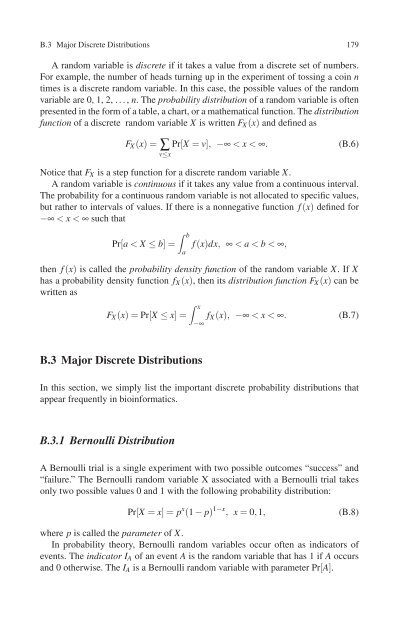You also want an ePaper? Increase the reach of your titles
YUMPU automatically turns print PDFs into web optimized ePapers that Google loves.
B.3 Major Discrete Distributions 179<br />
A random variable is discrete if it takes a value from a discrete set of numbers.<br />
For example, the number of heads turning up in the experiment of tossing a coin n<br />
times is a discrete random variable. In this case, the possible values of the random<br />
variableare0,1,2,...,n.Theprobability distribution of a random variable is often<br />
presented in the form of a table, a chart, or a mathematical function. The distribution<br />
function of a discrete random variable X is written F X (x) and defined as<br />
F X (x)=∑ Pr[X = v], −∞ < x < ∞.<br />
v≤x<br />
(B.6)<br />
Notice that F X is a step function for a discrete random variable X.<br />
A random variable is continuous if it takes any value from a continuous interval.<br />
The probability for a continuous random variable is not allocated to specific values,<br />
but rather to intervals of values. If there is a nonnegative function f (x) defined for<br />
−∞ < x < ∞ such that<br />
∫ b<br />
Pr[a < X ≤ b]= f (x)dx, ∞ < a < b < ∞,<br />
a<br />
then f (x) is called the probability density function of the random variable X. IfX<br />
has a probability density function f X (x), then its distribution function F X (x) can be<br />
written as<br />
∫ x<br />
F X (x)=Pr[X ≤ x]= f X (x), −∞ < x < ∞.<br />
(B.7)<br />
−∞<br />
B.3 Major Discrete Distributions<br />
In this section, we simply list the important discrete probability distributions that<br />
appear frequently in bioinformatics.<br />
B.3.1 Bernoulli Distribution<br />
A Bernoulli trial is a single experiment with two possible outcomes “success” and<br />
“failure.” The Bernoulli random variable X associated with a Bernoulli trial takes<br />
only two possible values 0 and 1 with the following probability distribution:<br />
Pr[X = x]=p x (1 − p) 1−x , x = 0,1,<br />
(B.8)<br />
where p is called the parameter of X.<br />
In probability theory, Bernoulli random variables occur often as indicators of<br />
events. The indicator I A of an event A is the random variable that has 1 if A occurs<br />
and 0 otherwise. The I A is a Bernoulli random variable with parameter Pr[A].

















